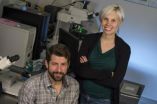(Press-News.org) A new study published in the journal Environmental Health Perspectives describes how exposure to air pollution early in life produces harmful changes in the brains of mice, including an enlargement of part of the brain that is seen in humans who have autism and schizophrenia.
As in autism and schizophrenia, the changes occurred predominately in males. The mice also performed poorly in tests of short-term memory, learning ability, and impulsivity.
The new findings are consistent with several recent studies that have shown a link between air pollution and autism in children. Most notably, a 2013 study in JAMA Psychiatry reported that children who lived in areas with high levels of traffic-related air pollution during their first year of life were three times as likely to develop autism.
"Our findings add to the growing body of evidence that air pollution may play a role in autism, as well as in other neurodevelopmental disorders," said Deborah Cory-Slechta, Ph.D., professor of Environmental Medicine at the University of Rochester and lead author of the study.
In three sets of experiments, Cory-Slechta and her colleagues exposed mice to levels of air pollution typically found in mid-sized U.S. cities during rush hour. The exposures were conducted during the first two weeks after birth, a critical time in the brain's development. The mice were exposed to polluted air for four hours each day for two four-day periods.
In one group of mice, the brains were examined 24 hours after the final pollution exposure. In all of those mice, inflammation was rampant throughout the brain, and the lateral ventricles -- chambers on each side of the brain that contain cerebrospinal fluid -- were enlarged two-to-three times their normal size.
"When we looked closely at the ventricles, we could see that the white matter that normally surrounds them hadn't fully developed," said Cory-Slechta. "It appears that inflammation had damaged those brain cells and prevented that region of the brain from developing, and the ventricles simply expanded to fill the space."
The problems were also observed in a second group of mice 40 days after exposure and in another group 270 days after exposure, indicating that the damage to the brain was permanent. Brains of mice in all three groups also had elevated levels of glutamate, a neurotransmitter, which is also seen in humans with autism and schizophrenia.
Most air pollution is made up mainly of carbon particles that are produced when fuel is burned by power plants, factories, and cars. For decades, research on the health effects of air pollution has focused on the part of the body where its effects are most obvious -- the lungs. That research began to show that different-sized particles produce different effects. Larger particles -- the ones regulated by the Environmental Protection Agency (EPA) -- are actually the least harmful because they are coughed up and expelled. But many researchers believe that smaller particles known as ultrafine particles -- which are not regulated by the EPA -- are more dangerous, because they are small enough to travel deep into the lungs and be absorbed into the bloodstream, where they can produce toxic effects throughout the body.
That assumption led Cory-Slechta to design a set of experiments that would show whether ultrafine particles have a damaging effect on effect on the brain, and if so, to reveal the mechanism by which they inflict harm. Her study published today is the first scientific work to do both.
"I think these findings are going to raise new questions about whether the current regulatory standards for air quality are sufficient to protect our children," said Cory-Slechta.
INFORMATION:
The research was funded by two grants from the National Institute of Environmental Health Sciences, a part of the National Institutes of Health, grant numbers ES012105 and ES001247.
New evidence links air pollution to autism, schizophrenia
2014-06-05
ELSE PRESS RELEASES FROM THIS DATE:
New findings out on brain networks in children at risk for mental disorders
2014-06-05
DETROIT – Attention deficits are central to psychiatric disorders such as schizophrenia or bipolar disorder, and are thought to precede the presentation of the illnesses. A new study led by Wayne State University School of Medicine researcher Vaibhav Diwadkar, Ph.D. suggests that the brain network interactions between regions that support attention are dysfunctional in children and adolescents at genetic risk for developing schizophrenia and bipolar disorder.
"The brain network mechanisms that mediate these deficits are poorly understood, and have rarely been tackled ...
Rice developing mobile DNA test for HIV
2014-06-05
Rice University bioengineers are developing a simple, highly accurate test to detect signs of HIV and its progress in patients in resource-poor settings.
The current gold standard to diagnose HIV in infants and to monitor viral load depends on lab equipment and technical expertise generally available only in clinics, said Rice bioengineer Rebecca Richards-Kortum. The new research features a nucleic acid-based test that can be performed at the site of care.
Richards-Kortum, director of the Rice 360˚: Institute for Global Health Technologies, and her colleagues reported ...
Iowa State, Ames Lab researchers find the mechanism that forms cell-to-cell catch bonds
2014-06-05
AMES, Iowa – Certain bonds connecting biological cells get stronger when they're tugged. Those bonds could help keep hearts together and pumping; breakdowns of those bonds could help cancer cells break away and spread.
Those bonds are known as catch bonds and they're formed by common adhesion proteins called cadherins. Sanjeevi Sivasankar, an Iowa State University assistant professor of physics and astronomy and an associate of the U.S. Department of Energy's Ames Laboratory, has described catch bonds as "nanoscale seatbelts. They become stronger when pulled."
But how ...
Short nanotubes target pancreatic cancer
2014-06-05
Short, customized carbon nanotubes have the potential to deliver drugs to pancreatic cancer cells and destroy them from within, according to researchers at Rice University and the University of Texas MD Anderson Cancer Center.
Pristine nanotubes produced through a new process developed at Rice can be modified to carry drugs to tumors through gaps in blood-vessel walls that larger particles cannot fit through.
The nanotubes may then target and infiltrate the cancerous cells' nuclei, where the drugs can be released through sonication – that is, by shaking them.
The ...
LSU biologist James Caprio, Japanese colleagues identify unique way catfish locate prey
2014-06-05
BATON ROUGE – Animals incorporate a number of unique methods for detecting prey, but for the Japanese sea catfish, Plotosus japonicus, it is especially tricky given the dark murky waters where it resides.
John Caprio, George C. Kent Professor of Biological Sciences at LSU, and colleagues from Kagoshima University in Japan have identified that these fish are equipped with sensors that can locate prey by detecting slight changes in the water's pH level.
A paper, "Marine teleost locates live prey through pH sensing," detailing the work of Caprio and his research partners, ...
Termites, fungi and climate change
2014-06-05
Climate change models could have a thing or two to learn from termites and fungi, according to a new study released this week.
For a long time scientists have believed that temperature is the dominant factor in determining the rate of wood decomposition worldwide. Decomposition matters because the speed at which woody material are broken down strongly influences the retention of carbon in forest ecosystems and can help to offset the loss of carbon to the atmosphere from other sources. That makes the decomposition rate a key factor in detecting potential changes to the ...
Brazil leads the world in reducing carbon emissions
2014-06-05
As the world turns its attention to Brazil with the opening of the World Cup this month, many people around the globe know the country's soccer fame, but few realize that it is the world's leader in reducing carbon emissions. A new study published in Science magazine provides the first in-depth analysis of how Brazil reached this global-leader status and managed to increase its agriculture production at the same time.
"Brazil is known as a leading favorite to win the World Cup, but they also lead the world in mitigating climate change," says the study's lead author, ...
New isotopic evidence supporting moon formation via Earth collision with planet-sized body
2014-06-05
A new series of measurements of oxygen isotopes provides increasing evidence that the Moon formed from the collision of the Earth with another large, planet-sized astronomical body, around 4.5 billion years ago. This work will be published in Science* on 6th June, and will be presented to the Goldschmidt geochemistry conference in California on 11th June.
Most planetary scientists believe that the Moon formed from an impact between the Earth and a planet-sized body, which has been given the name Theia. Efforts to confirm that the impact had taken place had centred ...
International collaboration explains sheep genome, secrets of unique digestive and metabolic systems
2014-06-05
HOUSTON – (June 6, 2014) -- An international team of scientists including the Human Genome Sequencing Center at Baylor College of Medicine has completed the first ever sequence of the sheep genome, shedding new information on the species' unique and specialized digestive and metabolic systems.
Sheep, a major source of meat, milk, and fiber in the form of wool, are important to the agriculture industry. This exploration of sheep genetic characteristics found features that comprise their specialized digestive systems including the rumen (the first chamber of their stomach ...
Amunix presents XTEN half-life extension technology at Next Generation Protein Therapeutics Summit
2014-06-05
Mountain View, CA – June 5, 2014 – Amunix Operating Inc. said today it is presenting unpublished data from its XTEN half-life extension technology development programs during two sessions this week at IBC's 9th Annual Next Generation Protein Therapeutics Summit in San Francisco, CA. Amunix is a biotechnology company developing hydrophilic, unstructured polypeptides which can be recombinantly fused or chemically conjugated to other peptides, proteins and small molecules.
Vladimir N. Podust, PhD, Director of Analytical Chemistry, Amunix Operating Inc., will present "Extension ...



